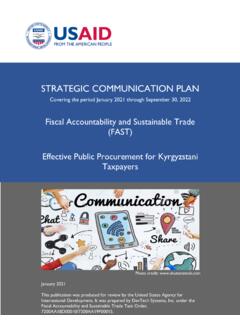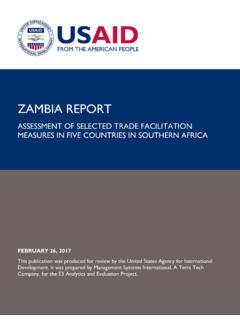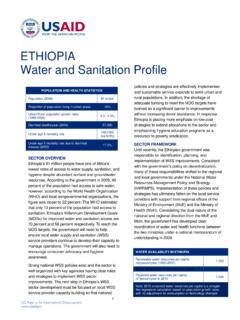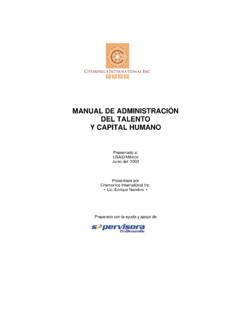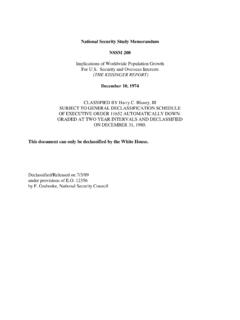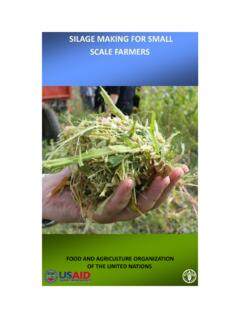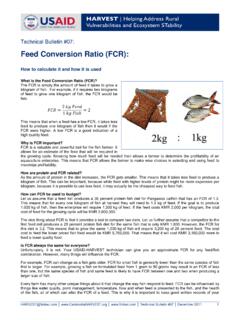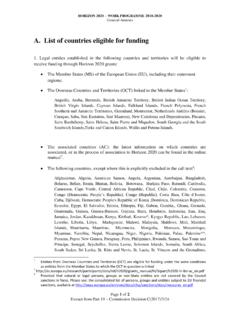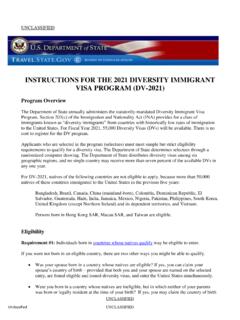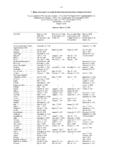Transcription of GLOBAL MARKET ASSESSMENT FOR HANDICRAFTS
1 GLOBAL MARKET ASSESSMENT FOR HANDICRAFTS VOLUME I FINAL DRAFT JULY 2006 This publication was produced for review by the United States Agency for International Development. It was prepared by Ted Barber and Marina Krivoshlykova of Development Alternatives, Inc. GLOBAL MARKET ASSESSMENT FOR HANDICRAFTS VOLUME I FINAL DRAFT The authors views expressed in this publication do not necessarily reflect the views of the United States Agency for International Development or the United States Government. FOREWORD III FOREWORD This paper was written as part of the Accelerated Microenterprise Advancement Project (AMAP) Business Development Services Knowledge and Practice (BDS K&P) research initiative. The AMAP BDS initiative s major objective is integrating micro and small enterprises into productive value chains to create wealth in poor communities. The research draws on experience and insights from: Interviews with leading handicraft buyers in the United States, the European Union, and the Caribbean, including importers and retailers currently sourcing from Haiti, those who have done so in the past, and those who source handmade products from other destinations; Interviews with MARKET experts, such as product development consultants, designers, enterprise development consultants, and marketing specialists who work with handicraft producers in developing countries ; Discussions with MARKET experts and USAID at a roundtable conducted in Washington, , on April 12, 2006; and Existing literature on the handicraft MARKET and home accessory industry.
2 This study provides an overview and analysis of the GLOBAL MARKET for HANDICRAFTS and the key trends that affect producers in developing countries , with the ultimate objective of offering practical recommendations for the Haitian handicraft sector. This paper represents Volume I of the GLOBAL MARKET ASSESSMENT for HANDICRAFTS study and includes Chapters I and II. Chapter I covers the GLOBAL MARKET for HANDICRAFTS and key industry trends and Chapter II focuses on the end- MARKET opportunities for Haitian products. The document is accompanied by a video: Handmade in Haiti: The Perspective of GLOBAL Buyers, which presents an overview of the MARKET for HANDICRAFTS and buyer perspectives on Haitian handicraft products. Volume II of this study (Chapters III V), to be prepared jointly by DAI and ACDI/VOCA, focuses on the supply-side constraints to Haitian HANDICRAFTS and offers recommendations for the development of a competitive strategy. This paper benefited from the intellectual guidance of Jeanne Downing at USAID and was prepared under the technical supervision of Lara Goldmark of DAI.
3 Annex I lists the many experts and buyers kind enough to share their time with the authors. In addition, the following roundtable participants deserve special recognition: Emiliano Duch, Randy Eller, Karen Gibbs, Colleen Pendleton, Guillermo Ricarte, and Alden Smith. LIST OF TABLES AND FIGURES V TABLE OF CONTENTS I. THE GLOBAL MARKET FOR HANDICRAFTS 1 DEFINITION AND ROLE OF COMMONLY ACCEPTED Challenges Associated with Definitions and Data THE GLOBAL MARKET FOR Players and Recent Changes and Nuances in How the Distribution Channels Price Segments ..15 Key Import Markets ..17 Key Export Markets ..18 TRENDS FOR THE UPCOMING Impact of Rapid Changes in MARKET Trends ..21 Towards Contemporary Minimalism ..22 The Push to Differentiate ..23 ..Channels Keep Getting Get Shorter ..26 Growth in Online Sales ..27 Where to, Trade Shows? ..27 Heightened Awareness of Environmental and Social Concerns ..28 The Future Competitive is in Asia ..29 II.
4 OPPORTUNITIES FOR HAITIAN HANDICRAFTS 31 HAITI AND THE Changes in the Landscape ..32 Purchasing ..34 Key Attributes ..38 HAITI: VIEW FROM THE Background ..41 Products ..42 Demand ..47 Buyers on Haitian BIBLIOGRAPHY 57 ANNEX 1: EXPERTS INTERVIEWED 1-1 LIST OF TABLES AND FIGURES Table 1 Home Accessory MARKET 2 Price Segments for Handmade Goods ..15 Figure 1 Handicraft MARKET Channels ..8 2 Dominant Handicraft MARKET Images in Chapter I Country Originals, Inc., Spring/Summer 2006 catalog. Country Originals, Inc., Spring/Summer 2006 catalog. Julio Balan, Croix des Bouquets, Haiti, 2006. Photo by Ted Barber. Country Originals, Inc., Spring/Summer 2006 catalog. Country Originals, Inc., Spring/Summer 2006 catalog. Artisans of Haiti, Aid to Artisans, 2003. Photo by Chantal Regnault. Artisans of Haiti, Aid to Artisans, 2003.
5 Photo by Chantal Regnault. FODAZE Gallery, Jacmel, Haiti, 2006. Photo by Ted Barber. FODAZE Gallery, Jacmel, Haiti, 2006. Photo by Ted Barber. Country Originals, Inc., Spring/Summer 2006 catalog. Artisans of Haiti, Aid to Artisans, 2003. Photo by Chantal Regnault. Country Originals, Inc., Spring/Summer 2006 catalog. Swahili Imports, Country Originals, Inc., Spring/Summer 2006 catalog. FODAZE Gallery, Jacmel, Haiti, 2006. Photo by Ted Barber. Aid to Artisans, Artisans of Haiti, Aid to Artisans, 2003. Photo by Chantal Regnault. Artisans of Haiti, Aid to Artisans, 2003. Photo by Chantal Regnault. Artisans of Haiti, Aid to Artisans, 2003. Photo by Chantal Regnault. Artisans of Haiti, Aid to Artisans, 2003. Photo by Chantal Regnault. Artisans of Haiti, Aid to Artisans, 2003. Photo by Chantal Regnault. Artisans of Haiti, Aid to Artisans, 2003. Photo by Chantal Regnault. Aid to Artisans, Artisans of Haiti, Aid to Artisans, 2003.
6 Photo by Chantal Regnault. Artisans of Haiti, Aid to Artisans, 2003. Photo by Chantal Regnault. Stephanie Armand, Dwelling LLC, Artisans of Haiti, Aid to Artisans, 2003. Photo by Chantal Regnault. Artisans of Haiti, Aid to Artisans, 2003. Photo by Chantal Regnault. Aid to Artisans, EXECUTIVE SUMMARY VII EXECUTIVE SUMMARY Handicraft production is a major form of employment in many developing countries and often a significant part of the export economy. With increased globalization, however, products are becoming more and more commoditized, with artisan producers facing increased competition from producers all over the world, particularly in China and other Asian countries . The home accessory MARKET , often used to estimate the demand for handcrafted goods, is strongly influenced by fashion, consumer purchasing patterns, and economic conditions in end markets. Keeping up with frequently changing MARKET trends presents a major challenge for handicraft exporters, and many observers fear that the advance of globalization has intensified this challenge and the precarious nature of work and existence in artisan communities everywhere.
7 However, globalization combined with growing markets for home accessories especially in the United States, Canada, and Europe also creates many new opportunities. In particular, the demand for cultural goods is projected to grow with rising international tourism and an increasing focus on interior decoration, and as a reaction (notably in upscale markets) to the homogenization of mass-produced products. Naturally, new opportunities bring new challenges: handicraft producers must be more responsive in adapting designs to buyer requirements, provide timely production and delivery, and improve quality and efficiency in view of increased price competition and consumer expectations. This study provides an analysis of the GLOBAL MARKET for HANDICRAFTS and reveals the following trends in the marketplace that impact handicraft producers in developing countries : There is a growing MARKET for home accessory products, particularly in the high-end segment. It is expected to grow not only in Western markets but in all regions as middle-class populations expand rapidly, particularly in China and India.
8 This trend suggests that there are numerous and expanding opportunities for artisans in developing countries to create products for these markets. China and India along with several other Asian countries currently dominate handicraft production worldwide, and are likely to continue to do so for the foreseeable future. Their position is based largely on low-cost, high volume, Western-designed goods. Many buyers and consumers seek unique products made in countries other than China. While the MARKET for purely indigenous designs is limited, GLOBAL style products that combine ethnic elements with contemporary designs is a growing category and represents an opportunity for handicraft producers. Low-end (priority on low prices) and high-end (priority on high quality) markets are expanding, while the middle (moderate quality at moderate prices) is relatively stagnant. Whereas competition at the low end is strong and requires significant production capacity, the luxury MARKET tends to focus more on distinctive designs, higher quality, and smaller quantities with greater flexibility in pricing.
9 Distribution channels in end markets are shortening. Large and, increasingly, mid-size retailers are importing directly, while small (and many of the mid-size) retailers continue to purchase merchandise principally, or entirely, from domestic wholesale importers. As this trend continues, many wholesale importers are losing important clients and many independent retailers are struggling to compete in a marketplace dominated by lower-priced big-box stores. However, there is evidence that savvy small retailers can compete with distinctive, high-end products. It is important to note that the vast majority of importers, both wholesale and retail, rely on the services of foreign exporters and agents, which many MARKET experts see as critical to the success of HANDICRAFTS in developing countries . VIII GLOBAL MARKET ASSESSMENT FOR HANDICRAFTS The large, direct-import retailers often operate in ways that present barriers to micro and small enterprises. Their purchase orders typically require high production capacities, strict delivery dates, and specific labeling, packaging, and packing.
10 Advance deposits are unusual, delayed payment terms are customary, and charge-back penalties for mistakes are common. While similar barriers exist with some wholesale importers, many order smaller quantities, offer prepayments to fund production with balances paid upon delivery, and have fewer requirements that could result in charge-backs. Buyers of all types prefer multiple product options to choose from, flexibility to make design modifications, and, above all, reliable partners. There are countless sources of product in the world vying for attention; what buyers seek most are items that sell from a producer who can deliver. Home accessories and d cor, gifts, and products for garden and outdoor living spaces are hot, with forecasted continued growth, as are products that are simultaneously decorative and functional. These categories present extensive opportunities for handicraft producers. Drawing on findings from the marketplace analysis and using Haiti as the basis for the MARKET ASSESSMENT , this study concludes that handicraft producers in developing countries should pursue the following strategies in order to compete in the GLOBAL marketplace: 1.
